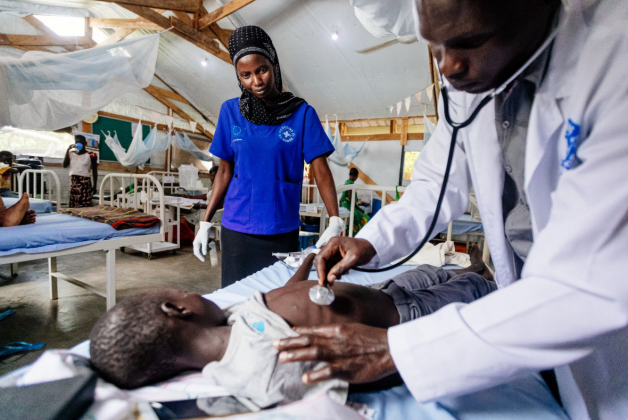Protection of humanitarian and health workers
Humanitarian and health workers are protected under international humanitarian law (IHL). Discover more about the concerning trends in aid workers security and what is being done to increase their protection.

Humanitarian and health workers both benefit from protection under IHL. Yet, amidst violent, complex and fast-changing conflicts, their security and safety are threatened and attacks against them show worrying trends. Humanitarian and health workers, especially local frontline workers, navigate high-risk environments to deliver aid to populations in need. Discover how States and the humanitarian community have been tackling this issue over the last decade and what non-governmental organisations’ (NGOs) priorities are to improve aid and medical workers’ protection.
Why is the protection of humanitarian and health workers a concern?
The protection of humanitarian and health workers is a long-standing concern for the humanitarian community. In 2022, the Aid Workers Security Database reported 444 attacks against humanitarian workers and the Safeguarding Health in Conflict Coalition reported 1989 attacks against health facilities and personnel, a 45% increase compared to last year and the highest number recorded in a decade. The protection of local and national aid and health workers is essential as they account for 90% of the victims. They are the direct implementers of aid and health services and their proximity to the most dangerous areas exposes them to the highest risks. Therefore, their protection must be considered a priority.
The humanitarian community has seen a growing trend of targeted violence against humanitarian and health personnel over the last ten years. Reportedly this is due to the politicisation of aid, alongside a growing disrespect for IHL, humanitarian principles and medical ethics. In addition, increasing targeted and indiscriminate violence against civilian populations and infrastructure characterises contemporary conflicts.
The protection of humanitarian and health workers is tightly linked with the protection of humanitarian space, and ensuring their safety and security is a prerequisite for delivering life-saving aid and healthcare in risky and remote areas, where the needs are the most acute.
Previous initiatives on the protection of humanitarian and health workers
Humanitarian and medical workers are protected by the Geneva Conventions of 1949 and their additional protocols, as well as several United Nations Security Council (UNSC) resolutions, such as resolution 2175 (2014), which focuses on the protection of humanitarian personnel, and resolution 2286 (2016), which specifically protects health workers and the medical mission.
States have adopted various political engagements to enhance the protection of humanitarian personnel. This includes efforts to enhance respect for IHL, humanitarian principles and medical ethics, as well as initiatives to fight against impunity for attacks and diplomatic support to ensure safe and unimpeded access. The humanitarian community has encouraged States’ leadership on this, resulting in initiatives such as the Security Council resolutions cited above, the “Call for Humanitarian Action” launched by France and Germany, a Discussion Series on “Ensuring the protection, safety and security of humanitarian workers and medical personnel in armed conflict” and other focused high-level discussions.
The humanitarian community has led various advocacy campaigns, such as the #NotATarget campaign. Some NGOs have been particularly vocal on the topic, often as a result of the tragic incidents involving the killing of their staff. Other NGOs are dedicated to this topic, such as the International NGO Safety Organisation (INSO), the Global Interagency Security Forum, Insecurity Insight, Humanitarian Outcomes, the International Red Cross and Red Crescent Movement and the Safeguarding Health in Conflict Coalition (SHCC). They have developed tools, resources, guides, research and advocacy activities to inform and enhance the humanitarian community’s effectiveness in better protecting humanitarian and health personnel.
Updated research on the protection of humanitarian and health workers
“The risks we face are beyond human comprehension: Advancing the protection of humanitarian and health workers” aims to advance NGO recommendations on how to effectively improve the protection of humanitarian and health workers. It highlights shared priorities from across the NGO community and operational steps to implement them.
Drawing from a questionnaire, interviews, and workshops the report finds four priority recommendations:
- Ensure the implementation of robust security risk management for NGOs with a focus on local and national NGOs through appropriate funding, and the mitigation of risk transfer from international actors.
- Health workers not affiliated with the aid system face the greatest risks and should also benefit from adapted security risk management, inspired from the good practices developed by NGOs.
- Scale the data collection, information sharing and analysis systems to enhance field security as well as informing advocacy and policy change.
- Address the politicisation of aid phenomenon and the disrespect for IHL, the humanitarian principles, and medical ethics.
Useful resources on the protection of humanitarian and health workers
Find more resources and tools on aid worker security risk management: HERE
For more tools and resources on data collection, sharing and analysis on security incidents consult these resources:
- INSO's Conflict and Humanitarian Data Centre (CHDC)
- The Aid Worker Security Data Base
- Insecurity Insight's Aid in Danger and Health Care in Conflict projects
- Insecurity Insight's Security Incident Information Management (SIIM)
- Toolkit: Evidence that Protects Healthcare